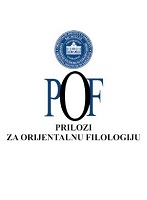Turski jezik u komentaru ‘Emsile’ Visočanina Osmana Šuglija: rečenice/konstrukcije odnosnog i izričnog značenja
Turkish Language in Commentary of ‘Emsile’ by Osman Şugli of Visoko: Sentences/Constructions of Relational and Assertive Meaning
Author(s): Kerima FilanSubject(s): Syntax, Finno-Ugrian studies
Published by: Orijentalni Institut u Sarajevu
Keywords: Turkish language; Bosnia, 17th century; scientific and textbook discourse; relational clauses; declarative clauses; verbal participles; verbal nouns;
Summary/Abstract: The paper analyses relational and declarative clauses in the manuscript titled Tuhfe-i Nâdiriyât-i Şuglî, which was in Sarajevo written by Osman Şugli in the 17th century in Ottoman Turkish. The autograph may be found in the Historical Archives of Sarajevo (sign. R–456). The analysis pertains to Şugli’s commentary of Emsile (fol. 64–117) which was used as a textbook for teaching the Arabic language in Ottoman maddrasahs. While conducting the analysis of the Turkish language used by Osman Şugli, relational and declarative clauses and constructions are examined in relation to their function and grammatical forms used. The paper proposes that literary language at the time was used in textbooks on grammar. The Turkish language of Osman Şugli is presented as a sample of the usage of language in scientific discourse. It may be concluded that the most frequent are complex subordinate clauses of relational and declarative value where the main clause is positioned at the beginning of the sentence and followed by the ki conjunction by means of which the subordinate clause is joined. In the present corpus, belonging to the genre of scientific prose, such a sentence structure demonstrates to be the linguistic means by which scientific facts and arguments are presented. The complex subordinate clause described above, which is different from the more natural way in the Turkish syntax of positioning the subordinate element in preposition, seems to intensify statements in the scientific discourse. It has also been concluded that these sentence structures express general views and ideas. The analysis also comprises phrases containing verbal adjectives and verbal nouns ending with –dIk and –mA.
Journal: Prilozi za orijentalnu filologiju
- Issue Year: 2016
- Issue No: 65
- Page Range: 29-50
- Page Count: 22
- Language: Bosnian

